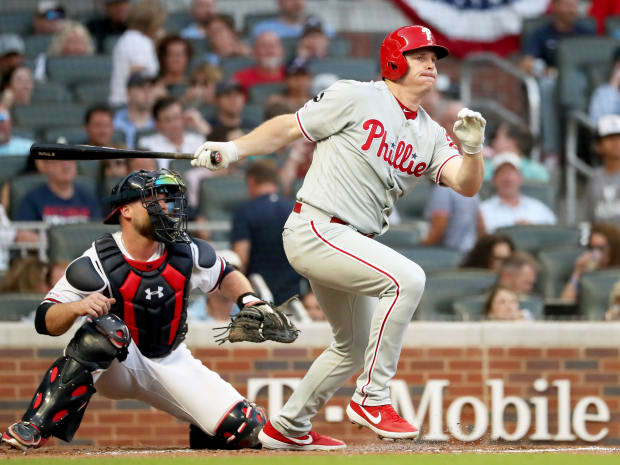Jay Bruce's career is a blatant example of how the growth of defensive shifts is harming baseball.
Welcome to The Opener, where every weekday morning you’ll get a fresh, topical column to start your day from one of SI.com’s MLB writers.
Jay Bruce retired Sunday after a 14-year career. His problem was not when his career ended but when it began. As a left-handed pull hitter without much speed, Bruce came along at the wrong time. If you want an example of how the growth of defensive shifts has harmed careers, Bruce is as blatant an example as any.

Since 2015, the use of shifts has more than tripled, from 9.6% of all pitches to 32.1% this year. Over that time, left-handed hitters such as Bruce, Brian McCann, Anthony Rizzo, Matt Carpenter and Kyle Seager have seen their careers turn for the worse because of the shifts they face in which one or two infielders position themselves on the outfield grass to their pull side.
Shift use has exploded because shifts accomplish their intended task—they depress offense. They are especially punitive to left-handed hitters who don’t run well. Take a look at what happened to Bruce’s hitting in the second half of his career as shifts grew against him:
Bruce to Pull Field
Bruce lost 107 points off his pull-side batting average and 92 points on his batting average on balls in play to that side. If Bruce had been able to maintain the same pull-side hitting in the second half of his career as he did in the first half, he would have had another 59 hits. Let’s imagine a Jay Bruce who didn’t have to deal with all of those shifts and compare those imaginary numbers to his actual career:
Maybe Bruce just declined quickly, the way some players do. Even if you grant that premise, there is no doubt the shift worsened his decline. Since 2015, the major league batting average on balls in play is .298. But when Bruce faced a shift, he saw his BABIP drop 82 points below league average. Only Albert Pujols had a worse shift-affected BABIP than Bruce did over these seven seasons.
Lowest BABIP vs. Shift, 2015-21 (Min. 4,000 pitches)
Hard-hit outs are another way to show how the shift hurt Bruce. The average major leaguer hits .544 when he hits a ball 100 mph or greater. Bruce hit 83 points worse than average when he absolutely smoked a pitch—the fourth unluckiest such average.
Worst BABIP with Exit Velocity 100+MPH, 2015-21
It’s not just the extreme hard-hit balls that shifts have turned from hits into outs. It’s the deep ground balls or those one-hop bullets to the second baseman who is flexed into short right field. If we count how many times a hitter was put out by an infielder from 135 feet or more away from home plate (essentially, beyond the infield dirt), Bruce shows up again as one of the hitters most harmed.
All six hitters who have been put out the most on these “deep infield” outs are left-handed, don’t run well and are former All-Stars—just not recently. The preponderance of shifts has helped keep them out at least the past three All-Star Games.
Most Infield Ground Ball and Line Drive Outs, 135+ Feet into Shift, 2015-21
Bruce pulled the baseball 45.1% of the time in his career. That’s fewer than left-handed hitters such as Tino Martinez (53.6%), Rafael Palmeiro (53.5%), Robin Ventura (50.9%), Fred McGriff (50.5%) and Garrett Anderson (49.7%). But all of them finished their careers before shifts became so popular. Ventura averaged 37.4 pull-side singles every 162 games; Bruce averaged 27.8.
MLB will experiment this year in the minors with two versions of curtailing the shift: keeping infielders on the dirt, and then in the second half of the season possibly banning three infielders on one side of second base.
Meanwhile, evidence that the shift is harming careers and the entertainment value of the game continues to mount. Entering this week, the major league batting average was .233, the third-lowest April batting average in the 102 years of the live ball era (1943, 1968). Batting average on balls in play is down to .286, the lowest in 29 years. Hits are at an all-time low. Strikeouts are at an all-time high.
The percentage of at bats in which the ball is not put in play (home runs, walks, strikeouts, hit batters) is up to 38%. And in the 62% of at-bats when a hitter manages to put a ball into play, the shift is taking away hits and affecting the careers of players like Bruce.
Seven years of evidence is enough. The shift is harming baseball and must go. The career of Jay Bruce—what it was and what it could have been—is the canary in the coal mine. It is too late for Bruce, but not for the next generation of hitters—and fans.
More From Tom Verducci:
• Four Players Have Already Walked Away From Baseball in 2021. Why?
• The Most Important MLB Season in Nearly Three Decades
• Francisco Lindor Wants to Save Baseball One Smile at a Time
• MLB Can't Wait Any Longer to Fix Its Pace of Play Crisis